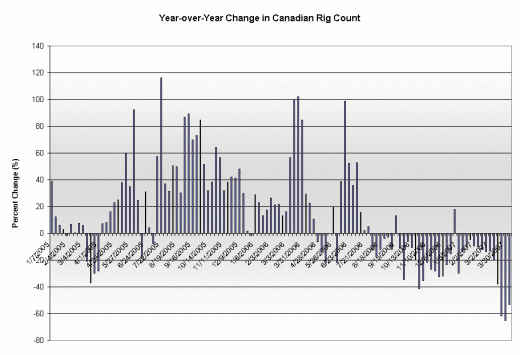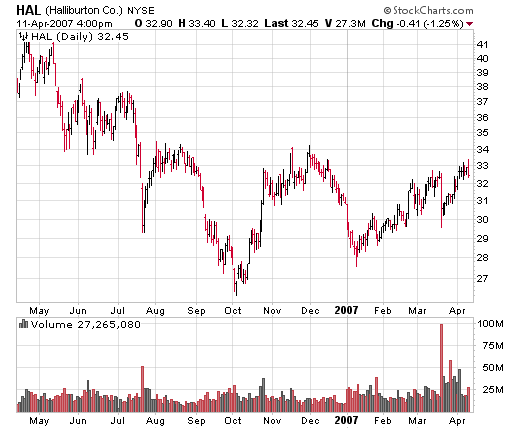Energy Corporate Earnings Season - Lowering the Bar
Companies / Oil Companies Apr 13, 2007 - 06:43 PM GMTBy: Elliot_H_Gue
 Corporate earnings reports for the first quarter are just starting to roll in; a slew of energy companies are scheduled to report earnings between now and the end of April. Earnings season is always an important time for stocks. Several times in the past two years comments from the bigger firms in the energy industry have revealed key emerging trends.
Corporate earnings reports for the first quarter are just starting to roll in; a slew of energy companies are scheduled to report earnings between now and the end of April. Earnings season is always an important time for stocks. Several times in the past two years comments from the bigger firms in the energy industry have revealed key emerging trends.
But investors often interpret earnings reports and management commentary the wrong way. You can't analyze a company's results in a vacuum, nor can you simply compare results with analysts' expectations and decide whether a release is positive or negative for the stock.
On countless occasions, I've seen companies show strong growth, handily beat estimates and make bullish comments on their conference calls, only to sell off in the wake of the release. The proper way to interpret earnings is to evaluate expectations and reactions.
This quarter, I'm not expecting to see many big surprises from the industry. The basic outlook has already been well telegraphed during the past few months: There's a clear bifurcation in the industry between international activity and North American operations.
North America has experienced a marked slowdown in drilling, exploration and development activity since the mid-2006. There are a few reasons for that. The most obvious is that a good deal of North American drilling activity is focused on natural gas rather than oil; the weakness in natural gas prices for much of last year makes gas production less profitable.
The first areas to slow down were coal-bed methane and Canadian shallow gas drilling. These are some of the highest cost gas resources in North America. Now that weakness has spread to other drilling markets.
Canadian drilling activity has slowed particularly quickly. Check out the Canadian rig count chart below for a closer look.

Source: Baker Hughes, Bloomberg
The rig count is nothing more than a measure of how many rigs are actively drilling for oil or gas in a particular region. The chart depicts not the actual rig count but the year-over-year change in the count. All the numbers are in percentage terms.
Note for most of 2005 the Canadian rig count was sharply higher than in 2004. During the summer months in 2005, the rig count was, on average, more than 50 percent higher than during the same months of 2004. This was great news for oil and gas services companies and contract drillers with operations in Canada; all that activity spelled rising prices for services and rising day-rates for leasing drilling rigs.
The picture began changing around the mid-2006. As you can see, the rig count began to shrink year-over-year alongside natural gas prices. The first weeks of 2007 were particularly brutal; the rig count has fallen sharply over the past year.
As you might expect, this has had profound effects on companies with exposure to North America and, in particular, Canada. A host of companies have actually come out to warn their earnings wouldn't meet estimates, guiding analyst expectations sharply lower. One of the more recent manifestations of this was a warning from oil services giant Halliburton on March 20.
Halliburton specifically cited weakness in North American activity as the driving force for its warning. I suspect that the company was particularly hard-hit by its exposure to North American pressure pumping.
To explain this business in brief, oil and gas exist in the pores and crevices of reservoir rocks, not in giant underground caverns or lakes. When an operator spuds a well, the oil and/or gas--under tremendous geologic pressure--flows through the rock into the well and then to the surface.
But if the pores in a rock aren't well connected, there are few channels through which the hydrocarbons can travel. Although there may be plenty of gas in the ground, that gas is essentially locked in the pores of the rock and unrecoverable.
But there are ways to produce such reservoirs. In the fracturing process, operators pump a gel-like liquid under tremendous pressure into the ground. That gel actually enters the reservoir and cracks the reservoir rock. By cracking or fracturing the reservoir rock, the operator creates channels through which gas can flow. These services are typically broadly dubbed pressure pumping.
The problem with pressure pumping is twofold. First, North America remains the dominant market--though that's starting to change. Second, because of huge demand for pressure pumping, services firms have added to their capacity at a rapid pace by building and purchasing new pressure pumping trucks and equipment.
This huge capacity growth was great when the market was going strong, but as demand slackened, a glut of pressure pumping capcity quickly developed. All this adds up to falling pricing power and lower profitability.
On the flip side, drilling activity outside North America has never been more robust. International projects tend to be larger-scale, multiyear affairs; such projects are far less sensitive to short-term commodity price gyrations.
And a good deal of international activity targets oil rather than natural gas. Oil prices are still off their 2006 highs but remain at high levels. In short, producers are making plenty of money on oil. Halliburton's international business continues to look strong.
At any rate, Halliburton's warning wasn't good news. Looking at the numbers and guidance, you'd probably have expected the stock to get slaughtered. And the rig count picture for North America—where Halliburton still derives most of its revenues—doesn't exactly look bullish for the company. But that simplistic take would be largely incorrect.
Halliburton's stock did fall on the day of the announcement. But look at what's happened over the past month:

Source: StockCharts.com
The lows on March 20 held, and the stock has actually been rallying since that time. By early April, Halliburton was actually trading above its pre-announcement levels. In fact, Halliburton set a new high for 2007 in April--hardly a drastically negative reaction to an ugly announcement and earnings warning.
Even more interesting was the action in BJ Services. I won't belabor the point by explaining all of BJ's operations; suffice it to say that the company is the most-heavily exposed to North American pressure pumping of any services firms I cover.
You may have expected BJ's stock to get hit hard in the wake of Halliburton's announcement. Unlike Halliburton, BJ doesn't have a large international presence to bail the company out.
But that didn't happen. Since Halliburton's March 20 warning, BJ Services is actually up just shy of 8.5 percent--a nice return in just the past few weeks. That's despite the fact that BJ Services' April 24 earnings release is almost certain to be replete with bad news about North America. In my view, the company may even miss its current consensus earnings estimates.
The positive reaction to negative news flow in BJ Services and Halliburton stocks is a far more valuable bit of information than the news itself. This reaction tells us an important fact about the industry: These stocks are already pricing some bad news about North America.
Although the underlying business in North America has deteriorated, the stocks are currently trading at a level that's attracting buyers on any dip. The bar of expectations has already been lowered enough for these stocks; they're now in an excellent position to rally through the upcoming earnings season.
A year ago, the market seemed to be totally ignoring the possibility that there would be a slowdown in the North American drilling market. Although there were certainly some early signs of trouble brewing, analysts weren't really factoring those problems into their numbers and estimates. But the sharp decline in activity I outlined above is no secret now; the market knows and expects these companies to report some negative numbers.
For the record, I'm currently recommending neither Halliburton nor BJ Services in The Energy Strategist (www.energystrategist.com). That said, I tempered my long-held bearish outlook for both stocks back in February. I already recommend a few stocks levered to activity in the region; now I'm looking at more ways of playing washed-out North America-focused stocks.
For those with a more-speculative bent, there should be some shorter-term trading opportunities in the next few weeks ahead of corporate earnings releases. I see very limited downside in North American services and drilling companies.
Meanwhile, if any of these companies unveil a sliver of good news, the stock would shoot higher. The extraordinarily strong options buying activity in a slew of North American services names suggests that some bigger players are already jumping into the group.
By Elliott H. Gue
The Energy Letter
© 2007 Elliott H. Gue
Elliott H. Gue is editor of The Energy Letter , a bi-weekly e-letter as well as editor of The Energy Strategist , a premium bi-weekly newsletter on the energy markets. Mr. Gue is also associate editor for Personal Finance , where he contributes his knowledge of the energy markets.
Mr. Gue has a Master's of Finance degree from the University of London and a Bachelor of Science degree in Economics and Management from the University of London , graduating in the top 3 percent of his class. Mr. Gue was the first American student to ever complete a full degree at that university.
© 2005-2022 http://www.MarketOracle.co.uk - The Market Oracle is a FREE Daily Financial Markets Analysis & Forecasting online publication.


